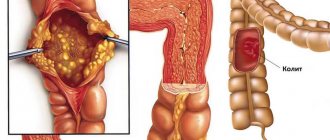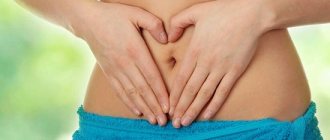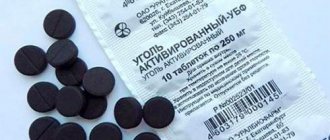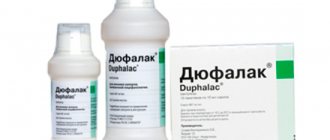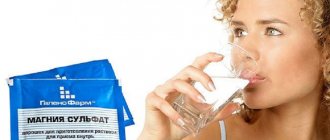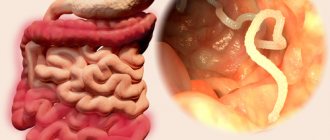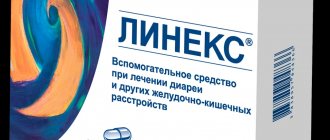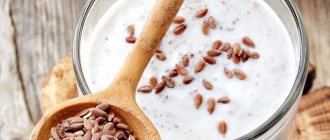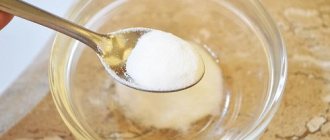The text is presented for informational purposes only. We strongly urge you not to self-medicate. When the first symptoms appear, consult a doctor. We recommend reading: “Why you can’t self-medicate?”
An enema to cleanse the intestines using a syringe is used for diagnostic and therapeutic purposes. It is prescribed to empty the lower part of the large intestine before conducting instrumental examination methods and administering a medicinal enema. Recommended for constipation and for the treatment of diseases of the gastrointestinal tract.
Depending on the temperature of the injected solution, the enema helps relieve spasm of smooth muscles or enhance intestinal motility. But this procedure can be dangerous.
Medical products (drugs, medicines, vitamins, dietary supplements) are mentioned for informational purposes only. We strongly do not recommend using them without a doctor's prescription. We recommend reading: “Why can’t you take medications without a doctor’s prescription?”
Contraindications
- gastrointestinal bleeding;
- intestinal obstruction;
- acute inflammatory processes of the colon, anus;
- the first days after surgery on the gastrointestinal tract;
- rectal prolapse;
- bleeding hemorrhoids;
- acute appendicitis;
- peritonitis;
- malignant neoplasms of the rectum;
- pathologies of the cardiovascular system.
The feasibility of the procedure is determined by the doctor.
Preparation for the event
Inventory
Before the procedure, prepare materials and instruments. Would need:
- oilcloth (approximately 150*100 cm);
- basin;
- napkin;
- balloon bulb (syringe);
- hydrogen peroxide 3% (if using a bulb with a hard tip);
- petrolatum;
- enema solution (prescribed by a doctor);
- sterile gloves.
For a cleansing enema, it is better to take a balloon bulb with a long tip (10–15 cm).
Since it is recommended to administer 1–1.5 liters of liquid for a complete bowel movement, it is better to take a syringe with a volume of 470 ml (for a salt, oil, emulsion enema, 100–200 ml is enough). Boil the pear for 10–15 minutes before use. If the tip is hard, remove it and soak it in a 3% hydrogen peroxide solution for 15 minutes. Then it is connected to the bulb.
Preparing your workspace
It is better to do the enema while lying on your side, and then remain in a lying position for at least 10 minutes. Therefore, you should prepare the place where the procedure will be performed.
An oilcloth is placed on the bed so that one end hangs from the bed (a basin is placed under it). The oilcloth is covered with a diaper.
Prepare an enema solution. Place it near the bed so that it is convenient to draw liquid into the syringe without changing position.
Why is a gynecological douche better than a regular one?
The gynecological bulb is superior to the classic one (for vaginal douching) in the following parameters:
- made of more durable and high-quality material;
- the pear itself is softer and more elastic, so it is more convenient to squeeze it when dosing the solution;
- The tip of the device is made of soft material and also has no roughness or sharp edges. Therefore, the likelihood of injury to the vaginal mucosa is minimal;
- Depending on the desired irrigation zone, you can use a syringe with one hole or several.
The only disadvantage of gynecological douches is their higher price than classic ones.
Enema solutions
Various solutions are used for cleansing enemas. The liquid temperature should be 22–23 °C, or 36–38 °C. The cold solution enhances intestinal motility and is prescribed for atonic constipation. Warm – relaxes, relieves spasms. If it is necessary to cause severe intestinal irritation, it is recommended to use liquid cooled to 12–20 ° C.
Prescribed solution:
- saline;
- soda;
- herbal;
- oil;
- emulsion;
- potassium permanganate.
Even boiled water is used for enemas.
Which solution to choose depends on the disease and the purpose of the prescribed procedure.
Saline
Hypertensive enemas effectively cleanse the intestines. They help remove a larger volume of fluid, soften stool, stimulate the release of loose stools, and enhance intestinal motility. Apply:
- 10% sodium chloride solution (10 g of table salt per 100 g of water);
- 20–30% solution of magnesium sulfate;
- 20–30% sodium sulfate solution.
Be sure to read:
Peristalsis: concept, norm and pathology
The procedure requires 100 ml of solution. It is heated to 37–38 °C. After administering the liquid, it is not recommended to stand up for 20–30 minutes.
It is contraindicated for ulcers, anal fissure, acute inflammation of the lower part of the large intestine, and edema.
Soda
Soda solution is prescribed for increased acidity of stool. It helps relieve pain caused by irritation of the intestinal mucosa with liquid feces during diarrhea. It is believed to be effective in the treatment of helminth infections. Recommended for cleansing the intestines with acetonemia.
To prepare the solution you need:
- 1.5 liters of water;
- 50–60 g of soda.
Sodium bicarbonate is dissolved in warm water. To cleanse the intestines, 1–1.5 liters of liquid are administered. The solution temperature should be 37–38 °C.
Herbal
Herbal infusions are recommended for cleansing enemas. Prescribed:
- Melissa infusion. Crushed shoots (3 g) are poured with a glass of boiling water and left for 20–30 minutes. Strain thoroughly. A warm solution (37–38 °C) should be administered. This enema relieves spasms.
- A decoction of flaxseed (oats, barley) and mallow leaves. The collection (1 tbsp) is poured into 1 liter of water. Boil for 10 minutes, filter, add 1 tbsp. l. salt, 2 tbsp. l. oil (linseed, hemp). I use this enema as a laxative for chronic constipation.
- Chamomile decoction. Chamomile flowers (6 tablespoons) are poured into 0.5 liters of boiling water. Place in a water bath and boil for 15 minutes. Allow the broth to cool, filter, and squeeze out the remaining raw materials. Add boiled water to the resulting broth to a volume of 0.5 liters. Add 2 tbsp. l. honey. This solution not only cleanses the intestines, it is anti-inflammatory and antibacterial.
Read more: Using herbs to cleanse the intestines
Decoctions should be prepared in enamel containers. It is better to buy plant raw materials at a pharmacy or collect them yourself (away from railways, roads, and factories). It is strictly not recommended to buy herbs by hand, as they could have grown in contaminated areas and harmful substances have accumulated in them.
Herbal enema solutions should be used only as prescribed by a doctor and with extreme caution - they cause allergies.
Oil
Used to empty the lower part of the colon from feces and gases during spastic constipation, in the postoperative period, after childbirth. This is a long-acting enema. After it you should lie down for at least 8 hours. Therefore, it is better to put it before bed (the act of defecation should occur in 10–12 hours).
The oil has the following effects:
- Mechanical. The solution penetrates between the feces and the intestinal walls. The feces soften and are easily excreted.
- Chemical. The oil in the intestines is partially broken down and saponified. It relieves spasms and helps restore normal peristalsis.
To prepare the solution, take 100–200 ml of vegetable oil (linseed, hemp, sunflower, corn). It is heated to 36–38 °C.
An oil enema is prescribed for a gentle cleansing of the intestines, when it is undesirable to strain the muscles of the perineum, abdominal wall, or strain. Its contraindications are the same as for all types of enemas.
Emulsion
It is recommended for seriously ill patients. Prepare an emulsion enema as follows:
- Prepare 0.5 ml of chamomile infusion. Chamomile flowers (4 tbsp) are brewed in 0.5 liters of water. Strain, squeeze out the remaining residue, add water to a volume of 500 ml.
- Take 1 yolk. Beat thoroughly. Add 1 tsp. baking soda.
- The yolk is mixed with chamomile decoction. Add 2 tbsp. l. Vaseline oil or glycerin.
Be sure to read:
List of products that strengthen the chair
When using an emulsion enema, bowel movement occurs within half an hour.
Potassium permanganate solution
For an enema, use a slightly pink solution of potassium permanganate. 4–5 crystals of potassium permanganate are dissolved in 1.5 liters of water heated to 36–38 °C. A more concentrated solution, instead of benefit, will cause irreparable harm (burn of the mucous membrane).
An enema with potassium permanganate is prescribed for treatment:
- diarrhea;
- hemorrhoids (if there is no bleeding).
To cleanse the intestines, it is better to use other solutions, since potassium permanganate dries out the mucous membrane and causes additional irritation.
How to carry out the procedure
An enema should be given only as prescribed by a doctor. The specialist will recommend which solution will be most effective, to what temperature it should be heated or cooled, and how much to administer.
Stages of the procedure:
- Wear sterile gloves.
- Lubricate the tip of the syringe and the anus with Vaseline.
- Lie on your left side, tuck your legs and bring them to your stomach. At the same time, manage to spread the buttocks with one hand, while holding a napkin near the anus, and insert the syringe with the other.
- The tip should enter the anus to a depth of 10–12 cm. Insert it carefully, using rotational movements.
- Slowly press on the balloon bulb and pour in its contents. You should not sharply squeeze the syringe, as strong pressure of liquid can damage the intestine. If you feel strong pressure or acute pain, stop the procedure immediately and seek medical help.
- The pear should be removed from the rectum carefully.
- Use a napkin to wipe the skin from the perineum to the anus.
- Close the buttocks tightly, carefully pull out the oilcloth with the diaper.
After administration, you should lie down on your left side for 10 minutes. Then roll over onto your right side. You should breathe with your stomach. This will help move water into the intestines. After an enema, you need to lie down for at least 20–30 minutes (except for an oil enema).
In case of anal fissure, the procedure must be carried out extremely carefully. An enema is given as many times a day as the urge to defecate occurs. The tip is inserted into the anus along the edge of the anus on the side opposite to the fissure.
Immediately after bowel movements, a bath with potassium permanganate is necessary. Then a suppository lubricated with novocaine, streptocide and zinc ointment is introduced.
To cleanse the intestines of toxins, the following scheme is recommended:
- Day 1 – before bedtime, 0.5 liters of liquid are administered;
- Day 2 – 1 liter of solution is administered;
- 4th day – 1.5 liters required;
- Day 7 – give a 2 liter enema.
On days 3.5 and 6 they take breaks. They are needed to prevent intestinal motility from being disrupted.
To administer large volumes of liquid, it is better to use an Esmarch mug, since the maximum volume of a syringe is about 0.5 liters. And administering an enema several times in a row will further irritate the intestines.
Cost of pears for douching
The cost of a gynecological pear depends on its volume, the manufacturer’s selling price and markups from the pharmacy:
- a syringe with a volume of 320 ml costs approximately 320 rubles;
- a syringe with a volume of 230 ml costs approximately 170 rubles.
The price is also affected by which tip is used for the device. With an irrigation nozzle, a pear costs about 30 rubles. expensive.
Douching eliminates inflammation, infection and reduces pain in the genitourinary system. But to achieve the desired effect, it is necessary to choose the right medicinal solution, the right dosage and course. But the most important thing is choosing the right gynecological pear.
Author: Kotlyachkova Svetlana
Possible complications and consequences
The procedure is carried out very carefully, as prescribed by the doctor, otherwise, instead of recovery, you can do a lot of harm.
- You should not give an enema often. The intestines will be “offended” and will not want to cleanse themselves. Enemas and laxatives contribute to the development of “lazy bowel” - a pathology that occurs due to weakened intestinal motility.
- The procedure helps cleanse the intestines not only of feces and gases, but also of beneficial microflora. And it is necessary for complete digestion and absorption of food. It has been proven that beneficial microflora helps strengthen the immune system. And without it, pathogenic microorganisms will begin to multiply in the intestines.
- If you insert the syringe incorrectly, you can damage the intestine. At best, a small wound will appear on the mucous membrane, at worst, a rupture will occur, and the entire contents of the intestine will fall into the abdominal cavity. Peritonitis will develop. Urgent surgery will be required.
- If there is no bowel movement after a certain time, intoxication may occur. Since harmful substances will dissolve and begin to be absorbed.
- When a large amount of fluid is administered, especially with pathologies of smooth muscle tissue, stretching of the intestinal walls will occur. The pressure inside the lumen will increase. This will lead to additional irritation and exacerbation of the pathological process.
Be sure to read:
What foods improve intestinal motility?
Therefore, before carrying out the procedure, compare the benefits and harms of an enema.
Precautionary measures
In order for the douching process to provide only the maximum benefit, before carrying out the procedure you should familiarize yourself with the following subtleties:
- The pear should not have a chemical smell. If it is present, then the device is made of low-quality material;
- the pear must be homogeneous, that is, without distortions, sagging and foreign inclusions. Also, the structure must be uniform and elastic;
- there should be no burrs or sharp edges on the nozzle, and its texture should be soft and elastic;
- joints should not be visible either on the nozzle or on the bulb;
- Do not inject the solution used under high pressure to speed up the completion of the procedure;
- It is forbidden to douche frequently, as this can lead to the development of inflammatory processes in the reproductive system;
- Using douching during pregnancy can lead to miscarriage or premature birth.
The most important rule is the ban on frequent use of douching, especially for preventive purposes. Since douching also destroys beneficial microflora, the procedure will ultimately lead to the development of dysbiosis in the vagina, increased dryness of the mucous membrane and the penetration of infection into the reproductive and urinary organs.
Advantages and disadvantages
Sometimes it is necessary to cleanse the intestines. When using a syringe for this, it is important to consider that it has its advantages and disadvantages.
| № | Advantages | Flaws |
| 1 | In the first stages of treatment, an enema is an effective means of cleansing the intestines. | Long-term use leads to impaired peristalsis, up to the complete loss of independent urge to defecate. |
| 2 | A syringe is convenient if you need to administer an enema yourself. | The maximum volume of the balloon bulb is 0.5 liters. And sometimes it is necessary to administer more than 1.5 liters of liquid. |
| 3 | When using a balloon bulb, liquid is injected into the intestines using a pressure method. Strong pressure helps flush out feces. | In certain pathologies, this method of administration will lead to complications (stretching of the intestinal walls, rupture of adhesions). |
| 4 | Promotes bowel movement from feces and gases. | Washes away beneficial microflora. |
| 5 | For the treatment of atonic constipation, an enema is good because it causes additional irritation and increases peristalsis. | Irritation of the mucous membrane increases inflammation, causes intestinal spasm and, accordingly, increases pain. |
Before using an enema, you must remember the contraindications. Sometimes it is better to replace it with other means.
Read on topic: How to cleanse the intestines with activated charcoal


